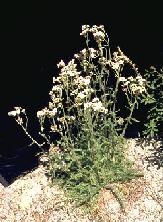
Copyright © 1995 Brother Eric Vogel,
St. Mary's College

Copyright © 1995 Brother Eric Vogel,
St. Mary's College
Common Yarrow
Achillea millefolium L.
ss. lanulosa (Nutt.) Piper
Perennial herb with a strong odor.
Individual plants usually grow somewhat more than one foot tall, often producing
several stems. The leaves are very finely divided and fernlike; the lower leaves
have leaf stalks and are longer than the upper, non-petiolate ones. Flat
topped with numerous minute white flowers often clustered about the same level.
Each head has three to five white rays. Grows almost everywhere in dry to relatively moist soil and flowers from May
through September. Only two species grow in the Rockies. First
identified by Nuttall from plants collected by Wyeth in 1832-33. Found in
southeastern Idaho.
Medicinal Uses: A decoction of everything except the root may be gargled as
a cure for sore throats or as a wound dressing. The teas is used for a
tonic and to treat colds and fevers by stimulating sweating and by lowering
blood pressure.. Yarrow mixed with
fat was used a hair dressing. It can also be washed
and crushed the roots to use for treating burns, and open sores. The
mashed leaves and roots were used as a pain-killer or for toothaches. Bathing in
infusions made of the leaves and stems was a suggested relief from rheumatism. Decoctions
of the plant were used as a tonic or astringent.
An infusion of the dried, flowering tops has been used from early times for medicinal purposes. It is stated to have diaphoretic, stimulant, and haemostatic properties. Indians of the north-west coast of North America make this plant into a poultice for use on skin rashes. Yarrow is anti-inflammatory and anti-spasmodic.